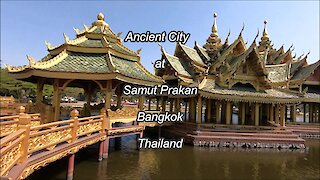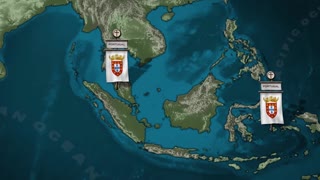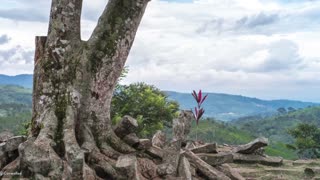Sonargaon Narayanganj The Ancient History Documentary of Bengal
This is the story of Sonargaon Narayanganj, The Ancient History Documentary of Bengal near Dhaka, Bangladesh. Sonargaon is an world heritage sites of Bangladesh was the capital of Bengal and it produced world's most popular and luxurious muslin clothes and exported them to all over the world including Europe, Asia, South Asia, Arab. Ancient Sonargaon played a key role in the world as the most popular river port. It has Panam city or Panam Nagar, Sonargaon Baro Sardar Bari and many other historical sites since thousands years.
Sonargaon was the highest paying state in the world from the end of the 13th century to about the 16th century especially when it was at its peak during mughal rule. It's residents lead luxurious lives as they earn big wages. A coin mint was established in it as well in that time.
After I explored the meghna river port we returned to the meghna river port terminal and headed towards the main and most exciting ancient port where Ibn batuta walked, lived and purchased his everyday essentials even though he bought two slaves before he left for Indonesia.
This is the ruins of 14th century's famous Khanqah’ and a madrasah including an underground passage Library and meditation room founded by Abu Tawwamah a islamic scholar in that time wherein all branches of Islamic learning as well as secular sciences were taught and studied. This madrasa earned a great reputation throughout the subcontinent and attracted students from far and near. Sharfuddin Yahya Maneri, the celebrated sufi scholar of Bihar, was a product of this madrasa. The present Dargahbari in Mograpara is possibly the site of that centre of learning. Maulana Sharfuddin Abu Tawwamah of Bokhara who came to Sonargaon sometime between 1282 and 1287.
The Madrasa has been maintained by his spiritual successors and later by the renowned saint Shah Ibrahim Danishmand and his descendants like Shah Kamel, Shaikh Muhammad Yusuf and others. This historical ruins of the building was a part of the madrasa or Dargah.
East of Sonargaon Bandar at Mograpara are the many historical remains such as, the Dargahbari complex with the Dargah building, Madrasa building, Fath Shah's Mosque (1484), Nahbat Khana, grave of Sharfuddin Abu Tawwamah, Tomb of Shah Ibrahim Danishmand, Tomb of Shah Kamel, Shaikh Muhammad Yusuf and Munna Shah Darwesh. The other remains of another group of spiritual saints lie further south in Damdama at Mograpara. Tomb of Ponkai Diwana at Gohatta, Panch Pir Dargah and a Mosque at Bhagalpur, Yusufganj Mosque, and Sheikh Saheb's Mosque at Darugola. Eminent There is the tomb of Sultan Ghiyasuddin Azam Shah.
Sonargaon is one of the old capitals of the historic region of Bengal and was an administrative center of eastern Bengal. It's hinterland was the center of the muslin trade in Bengal, with a large population of weavers and artisans. According to ancient Greek and Roman accounts, an emporium was located in this hinterland, which archaeologists have identified with the Wari-Bateshwar ruins a few kilometers away from this ancient port.
The Shitalakshya River was once an important center for the muslin industry.[1] Even today, there are centres of artistic weaving on its banks. There also are a number of industrial units on its banks, including the Adamjee Jute Mills. Thermal power houses are located along the river at Palash (north of Ghorashal) and at Siddhirganj.[1] Industrial affluent dumped into the river resulting in high levels of pollution is a cause for concern.
Several dynasties ruled this world's popular historical capital of Bengal but it gained importance during the Delhi Sultanate. It was the capital of the sultanate ruled by Fakhruddin Mubarak Shah and his son Ikhtiyaruddin Ghazi Shah. It hosted a royal court and mint of the Bengal Sultanate and also the capital of the Bengal Sultanate under the reign of Ghiyasuddin Azam Shah. Sonargaon became one of the most important townships in Bengal. Many immigrants settled in the area. The Sultans built mosques and tombs. It was later the seat of the Baro-Bhuyan confederacy that resisted Mughal expansion under the leadership of Isa Khan and his son Musa Khan. Sonargaon then became a district of Mughal Bengal. During British colonial rule, merchants built many Indo-Saracenic townhouses in the Panam neighborhood. Its importance was eventually eclipsed by the nearby Port of Narayanganj which was set up in 1862.
► subscribe to my channel:
► https://www.youtube.com/@alvievaoriginal
► follow my FB page:
► https://www.facebook.com/Alvievaofficial
-
 14:46
14:46
Alexander90
1 year agoANCIENT ADVANCED CIVILISATION #joerogan #shorts #history
26 -
 56:36
56:36
The Voice Asian
7 months agoLiterarily Speaking: Vains of Influnce, a panoramic depiction of colonial Sri Lanka, Ceylon
18 -
 15:07
15:07
MirkoKulig
1 year agoMalaysia Documentary
7 -
 9:36
9:36
TJAlex
4 years agoAncient City at Samut Prakan in Thailand
132 -
 0:34
0:34
BigJoeVol.2
9 months agoSkeleton Lake | Weird History #shorts #story #history #historyfacts #india
13 -
 5:21
5:21
stepburk
2 years agoCINEMATIC TRAVEL TOUR NEPAL | Experience Himalayan People, Culture and Scenery “Lifetime Experiences
642 -
 0:56
0:56
NotSoIntense
5 months agoThe Rebllion of the Ijiji #shorts #ancienthistory #history #anunnaki #sumerianrecords #billycarson
24 -
 11:14
11:14
Dwiandan
1 year agoHISTORY OF INDONESIA
5 -
 29:09
29:09
The 5th Kind
1 year agoBook of Enoch P.1 | The Anunnaki - Watchers and the Nephilim | Ancient Aliens Documentary
1.35K2 -
 10:45
10:45
HerlambangNP
1 year agoGunung Padang: A Masterpiece of Ancient Architecture From A Lost Civilization
4061